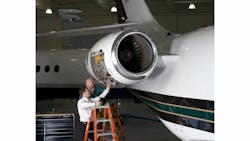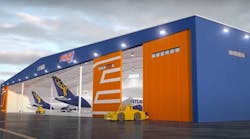Comprehensive hourly cost maintenance programs as we know them today didn’t really start to take shape until the late '70s and '80s. Early on, one of the most popular business jet engines, the TFE731, opened the door for the maintenance program concept because of the volatile costs for maintaining this asset. Aircraft owners and operators flying 731 engines understood the need for the new service, and it quickly became accepted policy to enroll onto an OEM program to cover unexpected 731 engine maintenance expenses.
Several years later, Jet Support Services, Inc. (JSSI) entered into the market with a different business model than the OEM and created independent hourly cost maintenance programs for virtually any turbine-powered engine in the market, all from a single provider. This unique financial service was accentuated with a qualified technical team of advisors to facilitate major inspections and overhauls for clients and provide around-the-clock assistance whenever they experienced AOG situations or unscheduled events. In 1989, JSSI only offered engine programs, but today, airframe and APU coverage options can combine to make up the Tip-to-Tail® all inclusive service that JSSI has trademarked. A few veterans from JSSI, celebrating its 25th year anniversary in business this year, have offered their insight as how this niche’ market has changed over the past quarter of a century.
Technical perspective –
Beyond 731 Engines:
Kurt Ruckersfeldt recalls that the majority of the early hourly cost maintenance customers were TFE731 operators and it was perceived as insurance at that time. Director of quality assurance, he has been with JSSI for 18 years. But when it came to convincing CF-34 engine operators that they could benefit from this type of program, they thought it only pertained to those other 731 operators. “The market understood that if they were flying TFE731 engines they needed coverage, so JSSI developed a robust alternative service to the OEM product. The challenge was getting the operators of other engine types to understand the universal value beyond the unscheduled 731 benefit,” explains Ruckersfeldt. “Once the evolution began and operators started looking at the true cost of running these turbine engines, it was like a light-bulb went on and the industry started accepting the idea of hourly cost maintenance programs, no matter what type of engine they were flying,” adds Ruckersfeldt.
As far as the fleet mix, Tim Ferrell, director of engine services, has seen JSSI’s original aftermarket focus of TFE731 and PT-6 engines evolve to long-range BR710 and CF-34 engines and on to airframe opportunities. He has been with JSSI for 15 years. “For airframe program coverage, owners that have been operating an aircraft longer, have a better understanding of their maintenance costs. Because of the recent economic recession, operators may be holding onto an aircraft longer these days, so the airframe and Tip-to-Tail coverage has become more attractive to many operators,” comments Ferrell.
On-Condition:
Coming from the airline side of maintenance, Ferrell was familiar with on-condition engine maintenance that utilizes sensor equipment to indicate when maintenance is needed in place of typical calendar/cycle engine maintenance. “This on-condition method wasn’t in the business jet market 25 years ago, but it is now making its way to the larger, long-range business jets. It does change the dynamics of the MRO industry to some degree. But from JSSI’s perspective, on-condition maintenance can give customers even more reason to consider an hourly cost maintenance program, because it is harder to predict if and when the engine might need to come off-wing for major maintenance,” adds Ferrell.
Parts:
Another change that Ferrell has seen over the years has been a trend to go with on-demand inventory and not stocking as many parts in an effort to keep overhead costs down. Unfortunately, according to Ferrell, this leaves a gap when needing parts immediately. Then fewer resources end up with more control over the supply of these parts and that can only lead to more costly parts for everyone. “We would like to see more competition with parts in order to keep costs more reasonable for everyone,” indicates Ferrell, “At any given time we can have 40 to 60 customers with engines off-wing, so quick access to parts at a fair price is a serious part of our business.”
Customer Service Perspective: Communication
E-commerce technology and communication advances have changed the way business gets done compared to 25 years ago, and some may say it has become more detached through less personal contact. According to Julie Bourke at JSSI, technology has transformed customer service roles around the globe, and it is no different at JSSI but they are adamant about keeping the personal touch alive. Bourke is client services supervisor and has been with JSSI for nine years. “Believe it or not when you call JSSI from anywhere in the world, you still get a live person. But this doesn’t mean we aren’t high-tech,” Bourke comments. “Our leadership believes in technology, so we have the latest customer relationship management (CRM) system in place and a customer application that allows clients to access their account at any time, day or night.”
The key to success, according to Bourke, is to have the right systems in place to quickly and easily address unique situations and offer creative solutions to meet the client’s needs. And all this needs to happen in a timely manner, which can be challenging, when you are working with customers in every time zone.
Bourke says, “as our customer base continues to expand and become more global, it is imperative that we provide exceptional 24/7 service to keep pace. Our major customer service centers are in Farnborough, UK, and in Chicago, IL, and we overlap customer representative’s schedules to cover all time zones and provide personal interaction with all our clients.”
Sales Perspective:
As mentioned earlier, JSSI’s Greg Hampton agrees that most of the industry understands the premise for hourly cost maintenance programs today but that was not the case 25 years ago. Hampton, director of business development for the heartland, has been with JSSI for 20 years. “The majority of my time 20 years ago was spent educating customers on how hourly cost maintenance programs work to provide budget stability,” Hampton mentions. “Now my time is spent talking with operators about our advantages over other programs and structuring the right program that works for their operation.”
Financial
Of the many evolutions he has witnessed over his tenure, Hampton notes that clients today are educated buyers, and there seems to be a higher level of financial responsibility. “Not only do aircraft owners and operators understand the value proposition of hourly cost maintenance programs but they work hard to manage their operation and utilize the aircraft as an efficient business tool. This fiscal responsibility includes managing their variable and fixed costs, and that is where our service comes in,” adds Hampton.
On another side of the financial perspective is the aircraft finance industry. Hampton mentions that there has been a substantial shift in the way the finance industry views maintenance programs. It used to be ‘nice’ to have an asset in their portfolio enrolled in a program, but today, in most cases, enrollment is a lender requirement in order to obtain aircraft financing.
Helicopter Opportunities
As the former helicopter programs sales manager, Hampton reflects, “Early on, helicopter operators weren’t ready to take the plunge with hourly maintenance programs. Today it is different; they are looking for ways to stabilize costs and be competitive, especially if they are a commercial operation.”
JSSI sees this rotary market as having great potential for hourly cost maintenance programs and as a result it has refocused efforts in this segment with additional business development resources, and multiple new helicopter maintenance programs are being developed and offered each quarter.
Summary
The hourly cost maintenance program market truly began on a large scale with the TFE731 engine operators, and today its focus stretches to any aircraft that burns Jet A fuel.
Today’s market is comprised of owner-flown King Air and Citation Jet pilots, to Fortune 500 flight departments utilizing Gulfstream G650 aircraft to travel the globe, and everything in between. The very diverse customer base may very well speak to the universal need to stabilize and manage aircraft maintenance costs, today more than ever, as the need for this unique financial service continues to evolve around the world.



